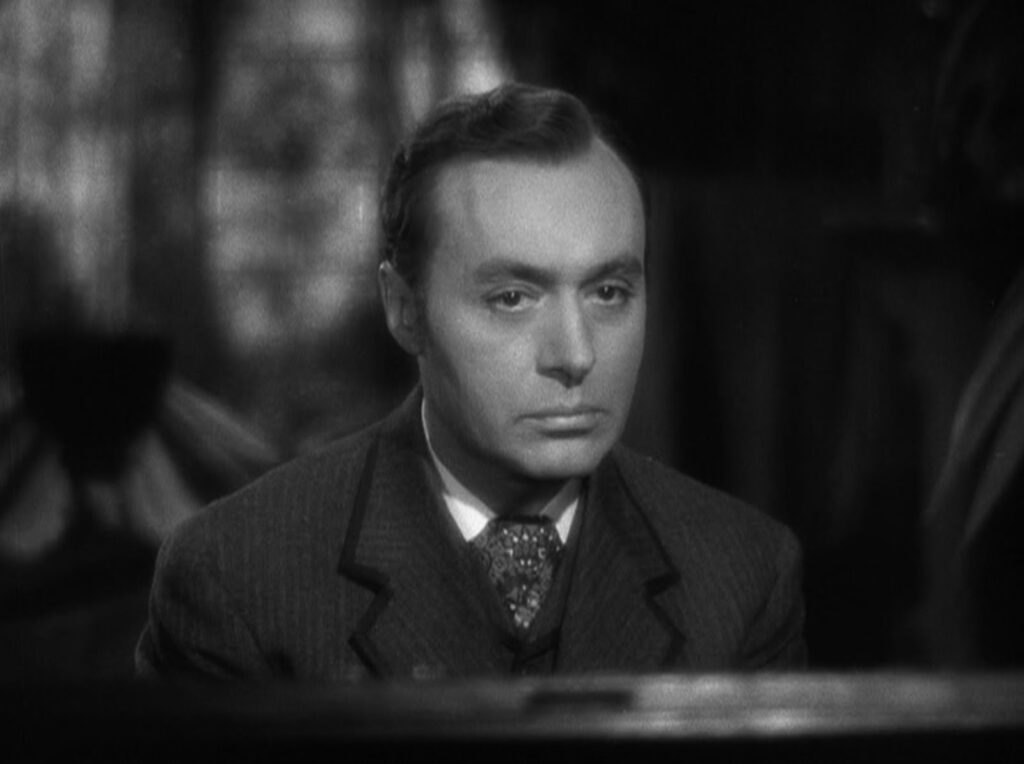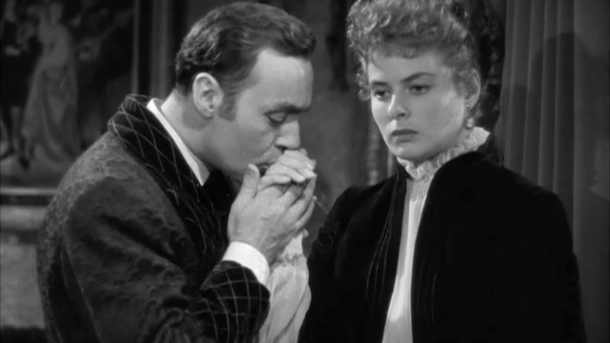If you’ve been tuned into modern discourse at all over the past couple of years, you’ve surely heard the term “gaslight” or “gaslighting” used here or there. The term is actually derived from the movie “Gaslight,” where psychological manipulation takes center stage. In this film, we witness the sinister machinations of Gregory Anton, played by the legendary Charles Boyer, against his unsuspecting wife, Paula Alquist, portrayed by the talented Ingrid Bergman.
Yet, beyond the surface-level drama lies a rich tapestry of storytelling techniques that elevate “Gaslight” to cinematic greatness. From its meticulously crafted suspense to its nuanced character portrayals, the movie “Gaslight” keeps audiences on the edge of their seats from start to finish. Each scene is carefully constructed to heighten tension and intrigue, drawing viewers deeper into the labyrinth of deception that Gregory weaves around Paula.
As we embark on this journey through the intricacies of “Gaslight,” we’ll unravel the layers of manipulation that define its narrative and uncover the timeless lessons it imparts. Join us as we explore the psychological depths of the movie “Gaslight” and discover why it remains a cinematic masterpiece that continues to captivate audiences and remain relevant decades after its release.
Setting the Stage: Understanding Gaslighting
Gaslighting isn’t just a plot device in the movie “Gaslight”; it’s a real phenomenon that many people experience in their lives. So, what exactly is gaslighting? Essentially, it’s a form of psychological manipulation where someone sows seeds of doubt in another person’s mind, making them question their own perceptions, memories, and even sanity. In the context of the movie “Gaslight,” Gregory Anton’s relentless gaslighting of his wife, Paula, serves as the driving force behind the film’s gripping narrative.
Real-Life Examples
In real life, gaslighting can manifest in various forms, from subtle manipulative tactics to overt psychological abuse. It often occurs in relationships where one person seeks to gain power and control over the other by undermining their confidence and sense of reality. This insidious behavior can have devastating effects on the victim’s mental and emotional well-being, leading to feelings of confusion, self-doubt, and isolation.
Psychological Manipulation in the Movie
In “Gaslight,” we see how Gregory systematically chips away at Paula’s sense of self-worth and autonomy, gradually eroding her confidence and independence. Through a combination of calculated lies, emotional manipulation, and psychological torment, he effectively isolates her from the outside world, leaving her vulnerable and dependent on him for validation and guidance.
By understanding the dynamics of gaslighting, we can better appreciate the complexity of the relationship between Gregory and Paula in the movie “Gaslight.” It’s not just a tale of suspense and intrigue; it’s a sobering reminder of the destructive power of manipulation and the importance of recognizing and confronting it in our own lives.
Deconstructing the Characters: Analyzing Manipulative Tactics
In the movie “Gaslight”, the characters of Gregory Anton and Paula Alquist serve as the focal points of the intricate web of manipulation woven throughout the narrative. Gregory, portrayed by the talented Charles Boyer, is the quintessential manipulator, employing a range of tactics to exert control over his wife, Paula, played brilliantly by Ingrid Bergman. Through a look into the characters, we can gain valuable insights into the nature of manipulation and its profound effects on both the perpetrator and the victim.
Character Analysis of Gregory Anton

Gregory Anton is the epitome of charm and sophistication, using his charisma and intelligence to disarm those around him. However, beneath his suave exterior lies a calculating and manipulative personality driven by a thirst for power and control. Throughout the movie “Gaslight”, Gregory employs a variety of tactics to gaslight Paula, including lying, deceiving, and distorting reality to make her doubt her own perceptions and sanity.
Character Analysis of Paula Alquist

Paula Alquist, on the other hand, is portrayed as a vulnerable and fragile individual who becomes increasingly isolated and dependent on Gregory as the story unfolds. Despite her intelligence and resilience, Paula falls victim to Gregory’s manipulative tactics, gradually losing touch with reality and succumbing to his gaslighting. Her character serves as a poignant reminder of the devastating effects of psychological manipulation on the human psyche.
Identifying the Tactics Used by Gregory on Paula
By deconstructing the characters of Gregory and Paula, we gain a deeper understanding of the dynamics at play in the movie “Gaslight”. Gregory’s manipulative tactics may seem cunning and calculated, but they ultimately stem from his own insecurities and fears. Likewise, Paula’s vulnerability and susceptibility to gaslighting highlight the profound impact that manipulation can have on an individual’s sense of self-worth and identity.
As we continue to analyze the characters of the movie “Gaslight”, we’ll uncover the complex interplay between manipulation, power, and control, shedding light on the darker aspects of human behavior and the enduring relevance of this timeless cinematic masterpiece.
Unraveling the Narrative: Exploring Storytelling Techniques

In the movie “Gaslight”, the storytelling techniques employed by director George Cukor are nothing short of masterful, drawing viewers into a world of suspense and intrigue from the very beginning. Through careful pacing, tension-building sequences, and expertly crafted plot twists, Cukor keeps audiences on the edge of their seats, eagerly anticipating each new development.
Suspense-Building Techniques
One of the most notable storytelling techniques in the movie “Gaslight” is its use of suspense to create a sense of unease and anticipation. From the eerie atmosphere of the Alquist mansion to the ominous presence of Gregory Anton, every scene is imbued with a palpable sense of tension that keeps viewers guessing until the very end. This suspenseful atmosphere heightens the impact of the gaslighting tactics employed by Gregory, making Paula’s descent into madness all the more chilling.
Usage of Twists
Another key storytelling technique in the movie “Gaslight” is its skillful use of plot twists to keep viewers engaged and invested in the story. Just when we think we have the mystery figured out, Cukor throws us a curveball, challenging our perceptions and forcing us to reevaluate everything we thought we knew. This narrative complexity adds depth and richness to the film, elevating it beyond a simple thriller and transforming it into a thought-provoking exploration of manipulation and deceit.
Questioning of Sanity
Central to the narrative of the movie “Gaslight” is the gradual unraveling of Paula’s sanity as she becomes increasingly ensnared in Gregory’s web of deception. Through cleverly constructed sequences and subtle visual cues, Cukor effectively conveys Paula’s growing sense of confusion and paranoia, drawing viewers deeper into her psychological turmoil. This gradual descent into madness serves as the emotional core of the film, eliciting empathy and sympathy from audiences as they bear witness to Paula’s tragic unraveling.
As we dissect the storytelling techniques employed in the movie “Gaslight”, we gain a newfound appreciation for the artistry and craftsmanship that went into its creation. From its suspenseful atmosphere to its skillful use of plot twists, Cukor’s direction elevates the movie “Gaslight” to cinematic greatness, leaving an indelible mark on audiences and critics alike.
Impact on Audience: Emotional Resonance and Psychological Depth

The movie “Gaslight” isn’t just a passive viewing experience; it’s a rollercoaster of emotions that leaves a lasting impression on its audience. From the gripping suspense to the heartbreaking portrayal of psychological manipulation, the movie “Gaslight” resonates with viewers on a deeply emotional level, eliciting a range of reactions that linger long after the credits roll.
The Uncomfortability of it All
At its core, the movie “Gaslight” taps into universal themes of betrayal, trust, and the fragility of the human psyche. By shining a spotlight on the devastating effects of gaslighting, the film invites audiences to reflect on their own experiences and relationships, prompting introspection and self-examination. Whether it’s through Gregory’s calculated lies or Paula’s heartbreaking descent into madness, the movie “Gaslight” forces viewers to confront uncomfortable truths about the darker aspects of human nature.
Evoking Sympathy for Paula
One of the most striking aspects of the movie “Gaslight” is its ability to evoke empathy and sympathy for its characters, particularly Paula. As we witness her gradual unraveling at the hands of Gregory, we can’t help but feel a profound sense of sorrow and indignation on her behalf. This emotional resonance speaks to the power of storytelling to elicit genuine emotional responses from its audience, fostering a sense of connection and empathy that transcends the screen.
Exploration of Reality and Delusion
Beyond its emotional impact, the movie “Gaslight” also offers a compelling exploration of psychological depth and complexity. Through its nuanced character portrayals and intricate plotting, the film delves into the depths of the human psyche, illuminating the intricate interplay between perception, reality, and identity. By confronting the uncomfortable truths of gaslighting head-on, the movie “Gaslight” challenges audiences to grapple with the complexities of manipulation and deception, prompting deeper reflection on the nature of truth and trust.
As we reflect on the emotional resonance and psychological depth of the movie “Gaslight”, we’re reminded of the enduring power of storytelling to provoke thought, evoke emotion, and spark meaningful conversations.
Conclusion
In conclusion, the movie “Gaslight” stands as a timeless masterpiece that continues to captivate audiences with its gripping narrative, compelling characters, and thought-provoking themes. Through its exploration of psychological manipulation and gaslighting, the film shines a light on the darker aspects of human nature, challenging viewers to confront uncomfortable truths about power, control, and deception.
Ultimately, the movie “Gaslight” serves as a powerful reminder of the importance of trust, truth, and self-awareness in our relationships and interactions with others. It prompts us to question our own perceptions and assumptions, challenging us to remain vigilant against the subtle tactics of manipulation that can undermine our sense of self-worth and autonomy.
And if you’re a new filmmaker who needs some extra help to get their short narrative film or short documentary put together, check out our film funding contest! If you win, you could earn up to $10,000 in funding for the production of your short film. No need to submit a completed script. Instead, all you need to do is send us a one-sentence summary of your film and why you need our funding. Learn more on our entry page!




